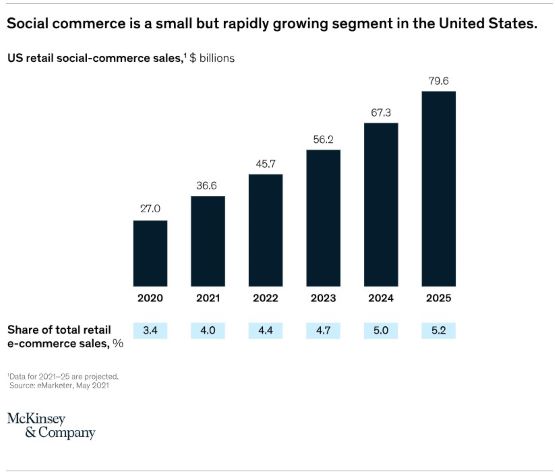
What’s happening in omnichannel retail? Key trends and stats
Not so long ago, “I’m going to the store” was a self-explanatory declaration. These days, it could mean any number of things: traveling to a physical location, navigating to a website, opening an app, or logging into social media.
Welcome to our omnichannel reality. For retailers ready to meet the challenge, there are plenty of rewards: Consumers spend more with brands that make shopping easy across channels and platforms, while mobile-first commerce, social selling, and evolving technologies are reinventing what’s possible. But expanding across channels can make it more challenging for retailers to provide a consistent customer experience, integrate data, manage inventory, and remain sales tax compliant.
What’s next? AI-powered personalization, immersive in-store experiences, and the rise of social commerce are shaping the future. In this post, we’ll explore today’s key omnichannel retail trends and how businesses can stay ahead.
Learn how to overcome the complexity of cross-channel commerce and other key growth barriers in our new ebook: Solving top tax compliance challenges for Shopify sellers
Key omnichannel retail trends to watch in 2025
For online sellers already spearheading an omnichannel retail strategy or getting ready to embark on this critical path to growth and scale, these are the important trends to keep on your radar.
Omnichannel has become a “strategic necessity”
In 2021, with the world collectively grappling with the impacts of the pandemic, McKinsey declared that a compelling omnichannel experience was no longer on the bleeding edge of retail, but instead a “requirement for survival.” Retail Dive echoed this sentiment in 2022, describing omnichannel as “now a baseline consumer expectation.” More recently, Ryder System Inc.’s 2024 study, The Influence of Omnichannel Excellence on Consumer Behavior further cemented the essential stakes of offering a smooth cross-channel retail flow.
“Omnichannel strength is not a fad,” said Jeff Wolpov, senior vice president of ecommerce for Ryder, “it is a strategic necessity for ecommerce and retail businesses to stay competitive and achieve sustainable success.”
Bridging the online and offline experience
One of the major findings in the 2024 Ryder study was that in-store shopping is regaining traction, with customers gravitating toward the unique advantages of browsing in physical stores: seeing products in person, trying things on, and making side-by-side comparisons, among others.
At the same time, though, customers still engage with these brands online and they want consistent, seamless experiences. Here are some of the techniques and trends that are helping create a blended and holistic experience for shoppers:
- Buy online, pick up in-store (BOPIS): Make a purchase online and conveniently pick up at a nearby store for immediate access.
- Endless aisles: Tablets or kiosks that allow shoppers to browse a retailer’s entire inventory from within a brick-and-mortar store.
- Unified loyalty programs: Persistent accounts that track purchases across channels, enabling personalized promotions and recommendations.
- Connected inventory and real-time stock updates: Customers can check product availability online before visiting a store.
“A seamless omnichannel experience fosters brand consistency and reliability,” said Brian Gleason, chief revenue officer at Criteo, in an article at Forbes. “Consumers easily transition between online research and in-store purchases, creating a sense of trust.”
The rise of social commerce
Platforms like TikTok and Instagram have fueled the rapid growth of social commerce, which enables users to discover and purchase products without leaving these social media apps. McKinsey estimated that the volume of social-commerce retail sales in the U.S. could reach nearly $80 billion in 2025.

As Shopify points out, there are a number of key benefits associated with social commerce, including reaching a larger target audience, creating a frictionless experience, and gathering data on your audience. Importantly, this approach also represents a way to better align with the behaviors and preferences of upcoming generations.
“Brands of all sizes need to … lean into fast growing channels like social commerce, especially if they want to meaningfully engage with younger demographics,” said Shopify’s Benjamin Lang at Econsultancy. “According to our Holiday Retail research, 59% of 18-24s said they shop via Instagram, while 62% do so through TikTok. With shoppers spending their time and money across so many channels, retailers must follow. Unified commerce is no longer an optional strategy, it’s table-stakes.”
Data quality as a prime differentiator
One of the biggest opportunities — and risks — involved with omnichannel retail lies in the handling and management of data. Engaging with customers and transacting through a variety of different channels can generate a tremendous amount of customer insight. But if you don’t have a strong foundation for keeping information from various sources and platforms centralized in a consistent and reliable way, this data deluge can create a lot of challenges.
Omnichannel retailers with unified data are able to unlock new levels of growth and efficiency, tapping big advantages on the front end and back end. As EY explains: “Insights from each channel combine to create a detailed picture of each customer’s habits and preferences, which not only enhances the potential for personalization but also can drive increased operational scale and lower cost of acquisitions for better margins.”
Cross-channel data consistency is key, so focus on leveraging tools that are flexible and integration-friendly. For example, Avalara for Shopify connects to Shopify directly, sending transaction data between platforms while automatically calculating tax obligations. Avalara offers connections with more than 1,200 signed partner integrations to support omnichannel selling.
AI-driven personalization and support
While the upside of omnichannel retail is easy to see, the downside is that it means more customer touchpoints to account for and optimize. Brands want to be not just available across channels, but able to provide high-quality, tailored experiences wherever their audience finds them. In this regard, AI technology is lending a big hand.
Examples of AI in omnichannel retail include dynamically personalized customer journeys, voice/visual search, real-time assistance, and predictive analytics.
Complex and ever-changing tax compliance
One potential roadblock for ecommerce merchants as they scale across platforms and increase the complexity of their omnichannel strategy: confidently staying on top of tax obligations. There are a lot of factors that come into play.
“Merchants want to sell their products, wherever their shoppers are,” said BigCommerce’s Sharon Gee in an episode of the OmniTalk podcast. “Whether that means they want to put their product on TikTok Shop, sell it on Instagram, or list it on Amazon, it often means bringing orders in from various different channels and fulfilling them in diverse ways, including, potentially the same way they fulfill their direct-to-consumer orders. The more channels, the more potential complexity. And all of those things trigger tax considerations.”
Keeping pace with all of those considerations manually can be an overwhelming task, but purpose-built solutions are at your disposal. Whether you’re running your store on BigCommerce, Shopify, or another popular platform, Avalara can power tax compliance for your omnichannel retail setup, allowing you to focus on growing and capitalizing on the above trends.
Learn more about omnichannel retail trends and how to thrive in a world of reshaped customer expectations:
Whitepaper: Omnichannel Retail: Automating Your US Sales Tax
Session from Avalara NEXT: Tax Compliance in an Omnichannel World

Your competitors live by this annual report
Trusted by professionals, this valuable resource simplifies complex topics with clarity and insight.
Stay up to date
Sign up for our free newsletter and stay up to date with the latest tax news.












